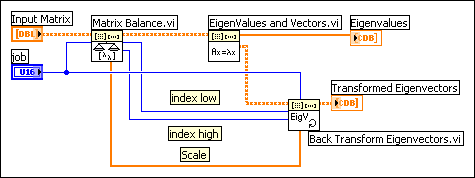Matrix Balance VI
Owning Palette: Linear Algebra VIs
Requires: Full Development System
Balances the general matrix Input Matrix to improve the accuracy of computed eigenvalues and eigenvectors. Wire data to the Input Matrix input to determine the polymorphic instance to use or manually select the instance.
You can use the Eigenvalues and Vectors VI to obtain the eigenvalues and eigenvectors of Balanced Matrix.
Use the pull-down menu to select an instance of this VI.
 Add to the block diagram Add to the block diagram |
 Find on the palette Find on the palette |





 j < index low. If you set job to
j < index low. If you set job to 





